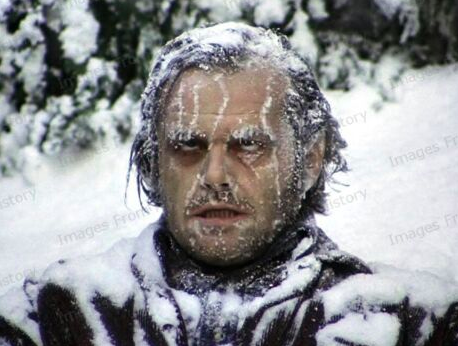
The snow is falling, the temperatures are dropping, and you’re wondering how to transition from fall to winter without freezing like Jack Nicholson in the final scene from The Shining. Everyone regulates differently, so take what I have to offer as a mere suggestion and adjust accordingly. In this article I will share are a few brands and products I’ve found to be extremely reliable—even below zero degrees Fahrenheit.
If you’re new to riding in the winter months, you might find this helpful. If you’re a seasoned veteran of the winter bike scene, read on if you’re looking to expand your repertoire.
My first rule of thumb is to tolerate a little cold and feeling underdressed at the beginning of a ride. But don’t worry, once you get your pedals turning and your heart pumping, you’ll warm up quickly. If you’re already warm at the start of your ride, you’ll likely overheat. Here are a few recommendations to keep you covered from tip to toe.
Up Top
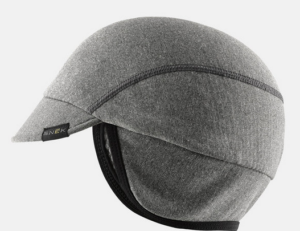
Let’s start with the basics. A solid base layer is key to this formula no matter how fast or slow you ride. If you’re riding hard on race day, a lightweight top is key. In fact, I’ll start with a short-sleeve top like the Snēk Cycling Dry Creek Merino T-shirt paired with their merino arm warmers. Most folks will ditch the arm warmers once the snow flies, but I like using them when I’m racing because I can peel them down under my long sleeve jersey if I’m overheating. The products from Snēk are high quality and super comfortable. They offer a wide range of merino offerings including one of my favorite go-to products this season, the Mid-weight Merino Cap. Unlike other caps I’ve worn in the winter, this one keeps my head and ears warm without overheating.
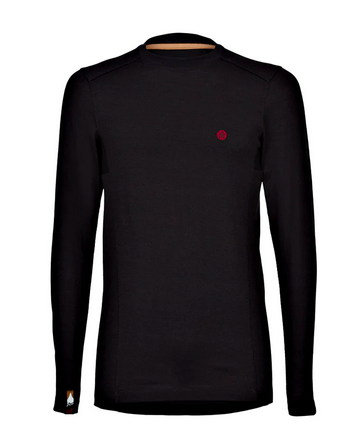
If you are not racing or chasing down a KOM on your favorite trail, then a mid-weight base layer is my recommendation. I’ve recently been wearing the Yushu Long Sleeve Crew Base Layer from Kora Outdoors. It is amazing. What sets this base layer apart from others is the Yak+Merino 60/40 wool blend. That’s right…I said Yak wool. If you’ve cruised the Fat-Bike.com pages over the years you’ve seen Uncle Gomez and yours truly review a variety of their products. Yak wool has more density than merino which translates to greater heat retention. In short, it is warmer ounce to ounce.
The Kora Yushu LS is incredibly comfortable, and warm, and like most base layers made with natural fibers, it is naturally odor resistant. I wore this shirt for days under heavy effort and never heard a word from my teammates demanding I freshen up my game. Unlike synthetic blends that stink after a single ride, the Yushu can be worn over and over reducing your carbon footprint and trips to the laundry mat.
For the next layer, I like the GORE Wear C3 Thermal Long Sleeve. The fleece-lined C3 jersey checks a lot of boxes for me. I like the cut and fit, it regulates well, and it is affordable. In fact, it’s 30-50 percent off right now on their website. I layer this with a short sleeve and vest in the fall, but it holds its own when old man winter shows up.
For the final layer, I have two options for you to consider. First is the Endura MT500 Freeze Point Jacket. Endura samples arrived late last season allowing considerable miles in this jacket last winter and into this season. Frankly, it is a bad-ass, stone-cold killer. I wore this jacket during last year’s edition of the Polar Roll Race in Ishpeming, Michigan. My crew treated the day more like a group ride than a race. It was the perfect companion for a long day in the saddle in freezing temperatures. The waterproof MT500 Jacket features multiple pockets to store supplies, zippered vents, rear pockets for a spare bottle, and a hood. Warmth comes from the Primaloft Gold insulation. You’d never guess how warm this jacket is by its weight, but I promise you it will keep you warm. I give this jacket a strong recommendation.
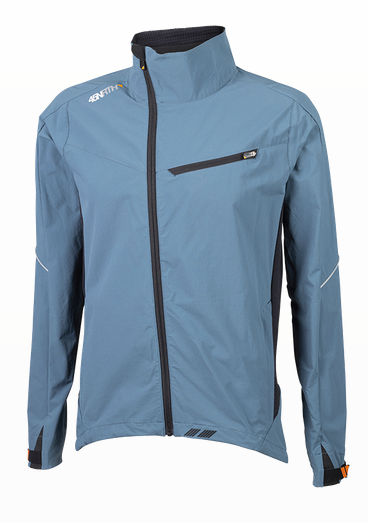
If you prefer a jacket without a hood, then look no further than the 45NRTH Naughtvind Jacket. The Naughtvind has been around for years but received a design overhaul this season. Available in Slate Blue and Black, this edition continues the 45NRTH tradition of producing high-quality, but pricey winter wear. But make no mistake, you get what you pay for. I’ve been riding in the Slate Blue sample Naughtvind jacket for the past two weeks. I’m impressed with the jacket’s heat retention, comfort, and unique color. Another feature I like in the Naughtvind is the ample arm length, rear pockets, and asymmetrical zipper. The 45NRTH Naughtvind will keep you well covered.
Down Below
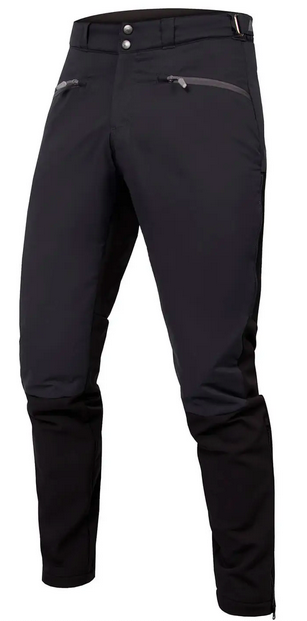
Here are a few recommendations for leg coverings depending on the type of riding I’m doing. If I’m riding hard for a shorter period, I start with a regular bib short. Some days I might also add a pair of Snēk Merino Knee Warmers for additional comfort. Knee warmers are great in this application because they won’t add another layer down near the ankle that might cause some crowding in your boots. Over the bibs and knee warmers I like the 45NRTH Naughtvind Winter Bib. These bibs feature a shorter calf-length which is a great feature to keep the leggings from bunching up in your boot. These bibs are super warm, but like the jacket and pant, prepare for sticker shock.
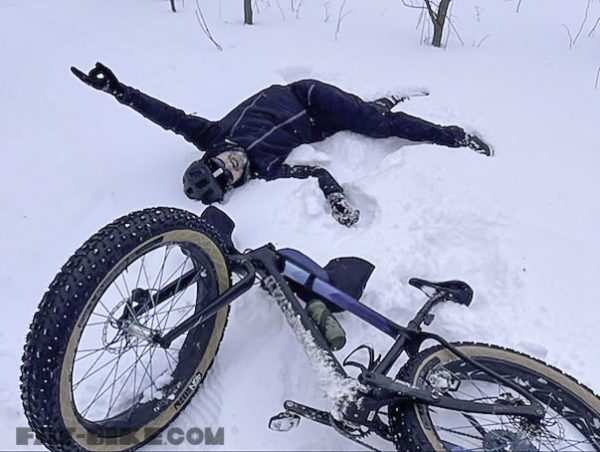
For more casual riding I really like the companion pants to the Endura and 45NRTH jackets. Both brands offer a pant to dial up your match-matchy game. Like the MT 500 jacket, the Freeze Point pant features Primaloft Gold insulation and wind-stop fabric in the thighs. Another added feature of the Freeze Point pant is the high-rise waist in the back to keep you well covered. Like the 45NRTH Naughtvind jacket, the companion pant received a design overhaul for this season. The pant features the same stretchy, weather-proof, wind-proof materials of the jacket allowing for amazing comfort, warmth, and movement.
Hands and Feet
Protecting my extremities is always a challenge. I’ve over-exposed my hands and feet over the years, so I need to be careful about protecting my hands and feet. I started riding with handlebar pogies last year. While I hate the way they look on the bike, I must admit, they do a great job of protecting my hands from the harsh winter elements. I don’t have a strong opinion about one brand over another. Just get a pair and try it out for yourself. Running a pair of pogies on your bars allows you much more freedom and dexterity. On warmer days you can go gloveless or wear a lightweight glove liner without issue. On colder days I start with a liner and lightweight gloves like the 45NRTH NøKKen or the Cross Point WaterProof Knit Gloves from ShowersPass.
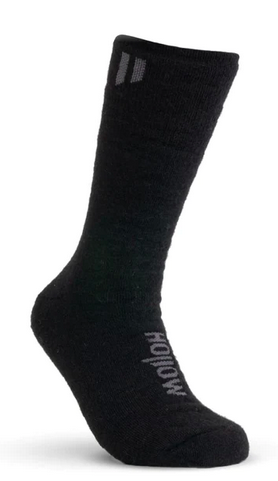
And now, we have the feet. Over the years I’ve had the pleasure of test riding boots from Lake, Bontrager, Blivet Sports, and 45NRTH. But before we talk about boots, we need to talk about socks. I consider my sock choice carefully matching my choice to the conditions and style of riding. Take note–I don’t mess around with cotton. Backcountry experts agree—cotton kills. On warmer days I might roll with a light-weight merino sock from my friends at Twin Six. But when it’s below 20 degrees I go to a winter weight sock with a light-weight merino liner. Last year I was introduced to two new sock brands-Herculan Wool and Hollow. Both feature natural fibers. Herculan utilizes “strong wool” which is thicker and stronger than traditional wool. They’ve held up extremely well over the last year. Hollow features alpaca fiber, and quite possibly the most luxurious thing I’ve ever wrapped around my toes. But both are incredibly comfortable, super warm, and durable.
It is hard to make a boot recommendation because everyone regulates body temperatures differently. And everyone has unique feet requiring special considerations. I need wide shoes and boots to match my wide foot. My recommendation is to match your choice with your riding style and conditions. The 45NRTH Ragnorok is great for temperatures down to 30 degrees. When shit gets serious, I reach for the Wølfgar.
Whatever your situation, movement in the toe box is important to allow for wiggle room. If your boots don’t allow you to wear a liner sock and a winter-weight sock, consider sizing up a little. You won’t regret having a little extra room in there.
So, there you have it. Proper layers and a little investment in quality outdoor winter wear will keep you rolling through the winter months. If you see an underdressed, axe-wielding maniac on the trail offer him some of these tips. Had Jack dressed appropriately before starting out on his murder spree, there might’ve been a sequel to The Shining.

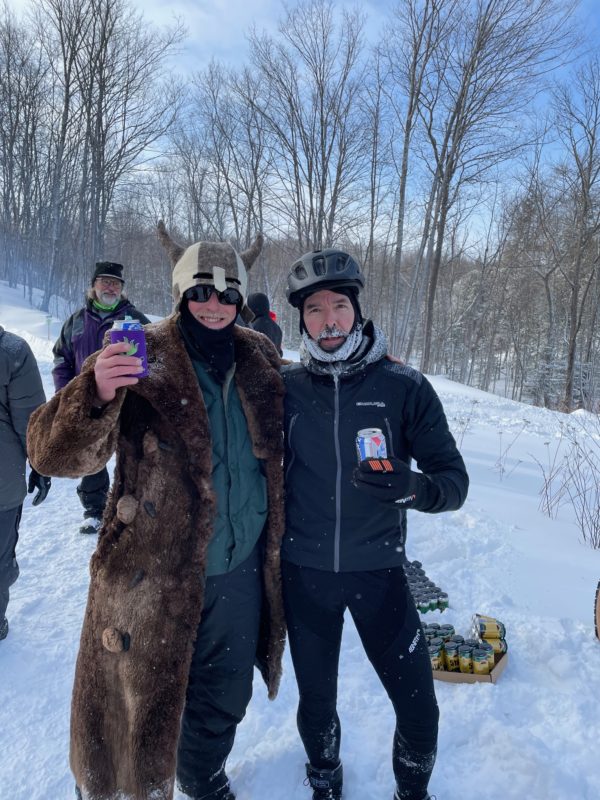
No comments yet.